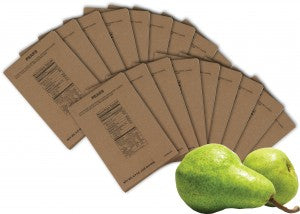Most of us are accustomed to having a wide variety of food choices available to us. Consider the dishes you ate at home in the last week. Then think of the types of food available in your local restaurants. More than any time in history, we can partake of the cuisines of many nations—Mexican, Italian, German, Chinese, Indian, Thai, and more—and our grocery stores often carry exotic produce that we may not even recognize. We take variety in our diet for granted, but if you were suddenly forced to depend upon your stored emergency food for sustenance, how much variety would you have?

The first thing to remember is this: While variety in your diet is important to us in our daily lives, in an emergency situation the critical factor in staying alive and strong is our calorie intake and the level of nutrients in our food. So focus your first storage efforts on meeting those basic needs, and once you’ve done that, you can easily add variety to your storage with some additional items.
To get an idea of some additional items you may want to add, prepare a sample week’s menu from just what you have on hand to see how you would fare. Can you extend that single week into two weeks without too much repetition? Menu fatigue is the result of a diet with limited variety, but it doesn’t take a gourmet chef to solve this. Adding salt, pepper and just a few other spices can make a big difference in the range of dishes you can create from food storage.

Another benefit of having more variety in your storage foods is that it will provide better nutrition (more variety of essential Vitamins and minerals) and a more satisfied dinner crowd. Wheat is nutritious and makes excellent bread and cereal, but it can also be so enjoyable if you were able to occasionally make some of it into pasta, crackers, or dumplings. Oatmeal, cracked wheat or 6-grain cereal are all healthy breakfast choices alone, but by adding peaches, berries, mango chunks, or banana slices, you can enjoy a totally different flavor. If you are able to have a selection of different grains, legumes, vegetables, fruits, meats and dairy products (including cheese) on hand, it will go a long way toward preventing menu fatigue. It will also give you many more ways to be creative with your menu. Including such vegetables as peppers, onions, and celery will allow you to make meat or meat-substitute dishes much more flavorful and healthful.

Keeping a supply of your favorite spices and flavoring agents on hand also gives you the opportunity to provide interest and variety at mealtime. Start with basic black pepper and iodized salt (which will provide the necessary trace mineral iodine as well as flavor enhancement). Include both sweet and savory spices and extracts such as vanilla, almond and coconut. A bottle of smoke flavoring, for example, adds an authentic taste to barbecue sauces and ham or bacon dishes. Take time to think of your family’s favorite seasonings and plan accordingly. Many seasonings are even available packaged for long-term storage.
Include baking soda and baking powder as well as yeast and dough enhancer for your baking needs. Obtain some needed fats—butter or margarine powder or shortening, oils, and powdered whole eggs for baking.
Another kind of variety to consider has to do with the resources required to use the stored foods. Grains and legumes are so important to have on hand. Learn how to prepare them in ways your family will enjoy. It is wise to practice when times are good. During conditions in which you can cook and bake as usual, all of your storage food will be useful to you. But during an extended loss of power and/or gas, you’ll need to make use of alternative cooking sources. Practice using these alternative cooking sources, whether it is a camp stove, gas grill, a Volcano, etc. Also, have food on hand that is quickly and easily prepared with little or no cooking. Perhaps you may be able only to boil a little water, in which case "just add water" foods will demonstrate their worth. Some regular foods such as pasta, instant rice, and hot cereals can be cooked over a period of time in a thermos by adding hot water and letting them stand. In other situations, you will want foods that can be eaten as-is or warmed quickly, such as MREs (Meals-Ready-to-Eat). Include some canned foods that provide water as well as ready-to-eat food in times when water might be scarce. For example, the juice from canned corn, pears or fruit cocktail. It would be wise to include foods in your storage program that fit into each preparation category. Prepackaged combos are often a great option because variety is usually a big factor of consideration.

So as you plan your food storage, remember these simple tips. Plan to get the basics first and then add variety to ensure that you have the things you need in an emergency. Sustaining life is the most important—and once you’ve met that need, you can add more foods to provide the same variety in your meals that you have now. The more your food storage resembles your day-to-day foods, the more at ease you and your family will be in what are otherwise stressful times. With some simple forethought and planning, your storage foods can be much more interesting and appealing than you might expect—and will better serve you to get through difficult times.








1 comment
Linda Sand
Seasonings are the biggest boost. A package of ranch dressing mix stirred into your beef will be very different from BBQ sauce stirred in or soy sauce or…